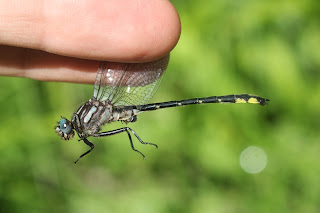Upon arrival to the canoe lauch, it sounded as though it was raining. But it was clear! The sound was a result of the Gypsy Moth caterpillars, which were nosily chewing. They were way too common! Gypsy Moths are an invasive and very destructive species.
There were a few Hagen's Bluets near the canoe launch, as well as some Northern Sunfish. Northern Sunfish are an uncommon species in Ontario, and were somewhat recently split from Longear Sunfish.
 |
| Hagen's Bluet |
 |
| Northern Sunfish |
And we were off! My first lifer dragonfly of the trip was a Cyrano Darner, but I couldn't catch or photograph it! We didn't get too far before having to portage up a flight of stairs and over the road, but after that minor glitch, we were back on the water.
I spotted a couple Lilypad Clubtails, another lifer. Again, no photos could be taken! Soon, we hit a patch of waterlilies. I saw some Skimming Bluets, which are pretty common. Then I spied a larger damsel, that had the tip of its tail pointed down resting on the lilypad. Could it be? It was! Lilypad Forktail! A few individuals of this rare species had been found a few days prior, so it was on my radar. A new one for me, and one I have been wanting to see for awhile.
They ended up being fairly numerous, and while I never caught one, I did get some nice photos.
 |
| Male |
 |
| Female |
I was quite pleased. We continued down the channel. We popped into a little marshy "inlet" to see what was there. I caught a Racket-tailed Emerald.
I didn't pay as close attention to plants as I would probably normally have, but still noted a few things. The channel is full of aquatic plants. This is a somewhat difficult group of plants, but I am quite fond of them! I'll have to go back just to look at those!
 |
| Flat-stemmed Pondweed (Potamogeton zosteriformis) |
 |
| Whorled Water-Milfoil (Myriophyllum verticillatum) |
A couple of sedges that are very similar in appearance, Bristly Sedge (Carex comosa) and Cypress-like Sedge (Carex pseudocyperus), were also found. They differ in the length of the teeth on the perigynia.
Hardstem Bulrush (Schoenoplectus acutus) was fairly abundant along the channel.
Okay, back to odonates.
We hit a little "pocket" of action. There were several Prince Baskettails, Common Green Darners, and even a couple Slaty Skimmers. As with the rest of the channel, Common Baskettails, Dot-tailed Whitefaces, Blue Dashers, and Eastern Pondhawks were common. Also a Cyrano Darner, with its distinctively arched abdomen.
 |
| Cyrano Darner |
 |
| Prince Baskettail |
 |
| Slaty Skimmer |
There were a couple birds of interest seen, including a Common Raven and a Sandhill Crane. The crane was likely with a colt (baby crane), but we couldn't confirm.
A bit further down the channel, we noticed several Elegant Spreadwings.
After awhile, we reached where the channel meets the river in Port Franks. Here we had considerable luck with clubtails.
 |
| Black-shouldered Spinyleg |
 |
| Lancet Clubtail |
 |
| Unicorn Clubtail |
A few bluets of interest were also seen. I probably could have turned up some more species if I had netted them, but still ended up with Stream, Hagen's, Skimming, Orange, and Rainbow.
 |
| Rainbow Bluet |
 |
| Skimming Bluet |
After five hours or so, we tallied 32 species of odonates, which I think is pretty good!
On our way home, we stopped at Fossil Road in Hungry Hollow. The river was higher than the week prior, which I think is why there were no dragonflies to be seen! I was a bit disappointed, but oh well. Here are a couple neat plants.
 |
| Dichanthelium lindheimeri |
 |
| Three-sqaure Bulrush (Schoenoplectus pugnens) |
 |
| Troublesome Sedge (Carex molesta) |











































